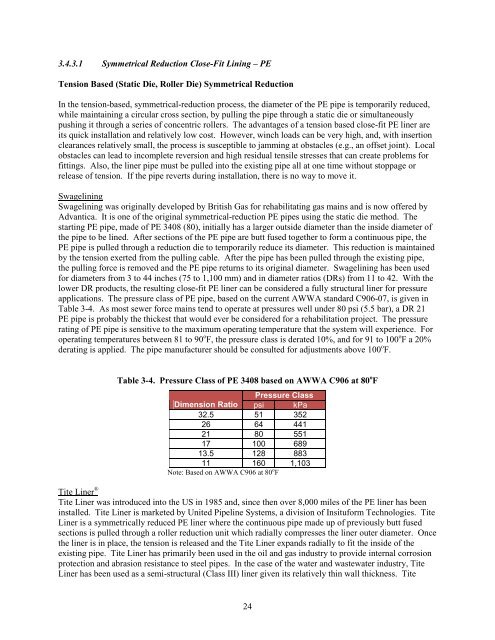State of Technology Report for Force Main Rehabilitation, Final ...
State of Technology Report for Force Main Rehabilitation, Final ...
State of Technology Report for Force Main Rehabilitation, Final ...
Create successful ePaper yourself
Turn your PDF publications into a flip-book with our unique Google optimized e-Paper software.
3.4.3.1 Symmetrical Reduction Close-Fit Lining – PE<br />
Tension Based (Static Die, Roller Die) Symmetrical Reduction<br />
In the tension-based, symmetrical-reduction process, the diameter <strong>of</strong> the PE pipe is temporarily reduced,<br />
while maintaining a circular cross section, by pulling the pipe through a static die or simultaneously<br />
pushing it through a series <strong>of</strong> concentric rollers. The advantages <strong>of</strong> a tension based close-fit PE liner are<br />
its quick installation and relatively low cost. However, winch loads can be very high, and, with insertion<br />
clearances relatively small, the process is susceptible to jamming at obstacles (e.g., an <strong>of</strong>fset joint). Local<br />
obstacles can lead to incomplete reversion and high residual tensile stresses that can create problems <strong>for</strong><br />
fittings. Also, the liner pipe must be pulled into the existing pipe all at one time without stoppage or<br />
release <strong>of</strong> tension. If the pipe reverts during installation, there is no way to move it.<br />
Swagelining<br />
Swagelining was originally developed by British Gas <strong>for</strong> rehabilitating gas mains and is now <strong>of</strong>fered by<br />
Advantica. It is one <strong>of</strong> the original symmetrical-reduction PE pipes using the static die method. The<br />
starting PE pipe, made <strong>of</strong> PE 3408 (80), initially has a larger outside diameter than the inside diameter <strong>of</strong><br />
the pipe to be lined. After sections <strong>of</strong> the PE pipe are butt fused together to <strong>for</strong>m a continuous pipe, the<br />
PE pipe is pulled through a reduction die to temporarily reduce its diameter. This reduction is maintained<br />
by the tension exerted from the pulling cable. After the pipe has been pulled through the existing pipe,<br />
the pulling <strong>for</strong>ce is removed and the PE pipe returns to its original diameter. Swagelining has been used<br />
<strong>for</strong> diameters from 3 to 44 inches (75 to 1,100 mm) and in diameter ratios (DRs) from 11 to 42. With the<br />
lower DR products, the resulting close-fit PE liner can be considered a fully structural liner <strong>for</strong> pressure<br />
applications. The pressure class <strong>of</strong> PE pipe, based on the current AWWA standard C906-07, is given in<br />
Table 3-4. As most sewer <strong>for</strong>ce mains tend to operate at pressures well under 80 psi (5.5 bar), a DR 21<br />
PE pipe is probably the thickest that would ever be considered <strong>for</strong> a rehabilitation project. The pressure<br />
rating <strong>of</strong> PE pipe is sensitive to the maximum operating temperature that the system will experience. For<br />
operating temperatures between 81 to 90 o F, the pressure class is derated 10%, and <strong>for</strong> 91 to 100 o F a 20%<br />
derating is applied. The pipe manufacturer should be consulted <strong>for</strong> adjustments above 100 o F.<br />
Table 3-4. Pressure Class <strong>of</strong> PE 3408 based on AWWA C906 at 80 o F<br />
Pressure Class<br />
Dimension Ratio psi kPa<br />
32.5 51 352<br />
26 64 441<br />
21 80 551<br />
17 100 689<br />
13.5 128 883<br />
11 160 1,103<br />
Note: Based on AWWA C906 at 80 o F<br />
Tite Liner ®<br />
Tite Liner was introduced into the US in 1985 and, since then over 8,000 miles <strong>of</strong> the PE liner has been<br />
installed. Tite Liner is marketed by United Pipeline Systems, a division <strong>of</strong> Insitu<strong>for</strong>m Technologies. Tite<br />
Liner is a symmetrically reduced PE liner where the continuous pipe made up <strong>of</strong> previously butt fused<br />
sections is pulled through a roller reduction unit which radially compresses the liner outer diameter. Once<br />
the liner is in place, the tension is released and the Tite Liner expands radially to fit the inside <strong>of</strong> the<br />
existing pipe. Tite Liner has primarily been used in the oil and gas industry to provide internal corrosion<br />
protection and abrasion resistance to steel pipes. In the case <strong>of</strong> the water and wastewater industry, Tite<br />
Liner has been used as a semi-structural (Class III) liner given its relatively thin wall thickness. Tite<br />
24















